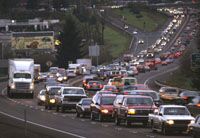
Light Rail Now/Light Rail Progress can be contacted at: Light Rail Now! |
Myth: Highways are an example of the free market system in action. Unlike public transportation, they receive no government subsidy, but rather are funded by user fees paid only by users. Reality: The notion that road users "pay their own way" in a "free market" process has a number of major faults. First, the evidence is clear that highway and motor vehicle-related taxes cover only part of the total costs of motor vehicle facilities. One of the most competent analytical discussions of this issue is provided by Dr. Vukan R. Vuchic in his book Transportation for Livable Cities (Center for Urban Policy Research, Rutgers, New Brunswick, NJ, 1999, pp. 67ff). Vuchic notes that the claim that highway users "pay their way" stems from the concept of the Highway Trust Fund, whose revenues are derived from taxes on motor fuels and other motor vehicle products. However, noted Vuchic, this fund fails to cover many important motor vehicle system costs, "such as highway maintenance, traffic regulation, and parking." Vuchic cites a wide range of analyses substantiating this, particularly those compiled and summarized by the following studies: * John Holtzclaw, "America's autos and trucks on welfare: A summary of subsidies", Mobilizing the Region, 15, 3 Feb. 1995. * John Pucher, "Budget cutters looking at wrong subsidies", Passenger Transport (APTA), 13 March 1995. These researchers cite studies performed by a variety of individuals and organizations, including the US Office of Technology Assessment (OTA), which provide estimates of "pure" subsidies to automobile and truck users in the USA ranging from as low as $300 billion to as high as $935 billion annually – nearly a trillion dollars a year (and that was in 1994)! "Thus," writes Vuchic, "the claim that car users pay their costs is overly simplistic and inaccurate. Actually, highway user taxes defray only part of the country's total highway transportation costs. Most car trips are subsidized." Vuchic further notes that a vast amount of heavy, hidden private subsidies actually exceed the total combined government and private subsidies "to all other modes ... combined." Vuchic summarizes the situation by observing that the 1994 OTA analysis (noted above)
Allocating special tax privileges to a particular industry is itself a form of governmental subsidy, since this method of revenue generation and funding cannot possibly be applied to all industries and companies throughout a given economy. Dedicating taxes on products (services) solely to the advantage of every individual product (service) would be disastrous for society as a whole. To single out a specific industry for this special treatment is thus an enormous subsidy to that industry. Basically, this is the legacy of a gigantic swindling of the American public in the mid-20th century by a working coalition of highway and motor vehicle industry interests. in essence, it amounts to a form of socialism for the rich. While this started with a relatively small number of service users (highway travellers), by distorting the market and eliminating or marginalizing other transport choices, this government promotion of highway travel has forced more and more users into this (monopolistic) system – all under the aegis of the state. The system thus feeds itself, in a vicious cycle of expansion (rather like a cancerous growth process). Furthermore, far from an example of a supposedly fair, "free market" process in action, it's a distortion of markets. Special revenue dedication and virtually unrestrained funding of highways also fail to account for external costs generated and incurred by the highway system (such as air pollution, accidents, etc.). Certainly, dedicating the taxes on a service or product to the support of that same service/product is a tremendously efficient way of fostering and aggrandizing the industry which provides it. How beneficial it would be for all tax revenue from shoes, boots, stockings, hosiery, canes, crutches, wheelchairs, foot-care products, shoe-repair products and services, etc. to be dedicated exclusively to the provision of pedestrian infrastructure – better sidewalks, lots of crossing lights, etc.! Unfortunately, the segmentation of tax revenue in this fashion would wreak disaster on governmental revenue and budgeting systems. Governments would find themselves boxed in, hands tied, in terms of their revenue allocation decisions. if this won't work for the society as a whole, why does a single industry (i.e., transportation system) deserve this special treatment and provision of these subsidies? Answer: it doesn't. At the time it was enacted (an era of muddy dirt roads and two-lane highways), special dedication of motor vehicle-related taxes to highways was seen as a fast emergency way to funnel lots of revenue into what was perceived as an essential public service. But the greedy Godzillas that had rapidly emerged within the highway and motor vehicle industries found this bountiful public largesse far too lucrative to lose. So they mobilized to preserve it – forming various Good Roads Associations and other political mechanisms that now make up Highways, Inc. – the government-corporate partnership which has eaten and assassinated its way to supremacy (carrying out the Transit Holocaust in the process) ... and supposedly locking in the "user fee" flim-flam forever. But one of these days – particularly as planners, decisionmakers, and the public at large become more savvy about the fallacies and adverse implications of this distortion of both markets and public policy – "forever" may come to an end. Light Rail Now! website Updated 2003/11/08 |
|
|
|